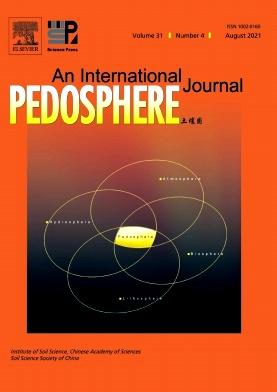甲烷的产生和氧化--关于 pmoA 和 mcrA 基因丰度的综述,以了解农业土壤的功能潜力
IF 7.3
2区 农林科学
Q1 SOIL SCIENCE
引用次数: 0
摘要
如果不解决土壤和其他生态系统中甲烷的排放问题,全球避免气候变化的努力就不可能成功。甲烷是一种温室气体,它在大气中保留热量,导致全球变暖。它的产生是有机物分解的最后一步,由携带功能基因mcrA(编码甲基辅酶M还原酶)的产甲烷古菌产生。甲烷生产是指在嗜气或厌氧环境中,在甲基辅酶M的催化作用下,醋酸盐或二氧化碳的还原生成甲烷。另一方面,甲烷氧化细菌,也称为甲烷氧化菌,通过颗粒甲烷单加氧酶(pMMO)的催化作用,氧化甲烷并减少其排放到大气中。从本质上讲,甲烷的产生和消耗都发生在土壤中。产甲烷菌和产甲烷菌生活在相同的土壤环境中。事实上,产甲烷菌和富甲烷菌活动和丰度之间平衡的改变可能会影响土壤甲烷排放和全球变暖。本文综述了甲烷通量的驱动因素、pmoA(编码pMMO)和mcrA基因丰度、甲烷排放与控制、微生物功能基因丰度与土壤功能的关系以及土壤中pmoA和mcrA基因丰度的研究方法等方面的最新进展。我们还强调了需要填补的空白,以及mcrA/pmoA基因丰度比对土壤甲烷排放率的影响。我们还讨论了控制pmoA和mcrA基因丰度的各种非生物因素。本文章由计算机程序翻译,如有差异,请以英文原文为准。
Methane production and oxidation–-A review on the pmoA and mcrA gene abundances for understanding the functional potentials of agricultural soils
Global efforts to avert climate change cannot succeed without tackling the emission of methane from soil and other ecosystems. Methane is a greenhouse gas that retains heat in the atmosphere and causes global warming. Its production is the last step of organic matter decomposition, and it is produced by methanogenic archaea bearing the functional gene mcrA (encoding methyl-coenzyme M reductase). Methane production involves the reduction of acetate or carbon dioxide in a microaerophilic or anaerobic environment under the catalytic actions of methyl-coenzyme M to generate methane. On the other hand, methane-oxidizing bacteria, also known as methanotrophs, through the catalytic action of particulate methane monooxygenase (pMMO), oxidize methane and reduce its emission to the atmosphere. In essence, both production and consumption of methane happen within the soil. Methanotrophs and methanogens inhabit the same soil environment. In fact, a shift in the balance between methanogen and methanotroph activities and abundances could influence soil methane emission and global warming. In this review, we highlight recent advances in drivers of methane flux, pmoA (encoding pMMO) and mcrA gene abundances, methane emission and control, relationships between microbial functional gene abundances and soil functions, and methods for studying the pmoA and mcrA gene abundances in soil. We also highlight gaps that need to be filled and the impact of the mcrA/pmoA gene abundance ratio in driving the methane emission rate in soil. We also discuss the various abiotic factors that control pmoA and mcrA gene abundances.
求助全文
通过发布文献求助,成功后即可免费获取论文全文。
去求助
来源期刊

Pedosphere
环境科学-土壤科学
CiteScore
11.70
自引率
1.80%
发文量
147
审稿时长
5.0 months
期刊介绍:
PEDOSPHERE—a peer-reviewed international journal published bimonthly in English—welcomes submissions from scientists around the world under a broad scope of topics relevant to timely, high quality original research findings, especially up-to-date achievements and advances in the entire field of soil science studies dealing with environmental science, ecology, agriculture, bioscience, geoscience, forestry, etc. It publishes mainly original research articles as well as some reviews, mini reviews, short communications and special issues.
 求助内容:
求助内容: 应助结果提醒方式:
应助结果提醒方式:


